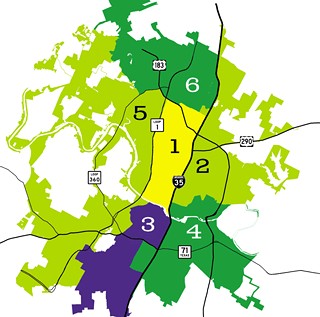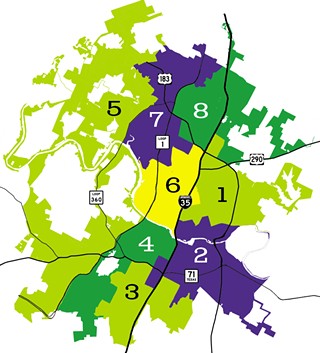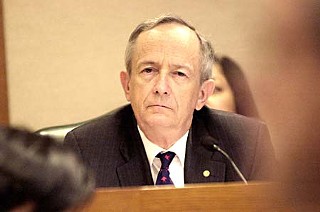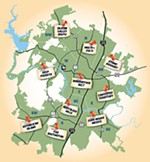The Single-Member Situation
Movement afoot – once again – to ask voters to approve City Council districts
By Wells Dunbar, Fri., Feb. 25, 2011
Is seven the lucky number for single-member districts?
Six times previously, the city has put before Austin voters the question of single-member districts – a change to the city's currently at-large form of local government whereby some or all City Council members would reside in and represent specific geographic areas instead of running and representing citywide.
And six times, since 1973, voters have rejected the proposal.
That might change. Mayor Lee Leffingwell is set to announce a proposal for SMDs at his annual State of the City address this week. The current City Council has expressed support for SMDs – with varying degrees of enthusiasm – as have several candidates running for council seats this spring. The 2010 census data, central to any geographic delineation of the city, was released days ago. And a host of others outside the city have piped up in support of the concept – some arguing that the mayor's 2012 proposal should be fast-tracked even sooner. A critical mass seems to be building in support of single-member districts – but it's a wave that will have to be sustained in order to make a seventh outing successful.
A Tidal Shift?
"It may be an idea whose time has come," says Leffingwell, noting the growing chorus of voices calling for SMDs. "The group of people that are pushing for geographic representation has changed and increased – what we're seeing now are folks from the suburbs, not just East Austin but Southwest Austin and Northwest Austin, who feel like they're left out, basically. They're very much in favor of it too."

Aside from promoting geographic diversity on the dais, the mayor feels SMDs would allow individual candidates to contest for a seat who wouldn't otherwise have a chance, considering the daunting and growing expense of a citywide campaign. "Different kinds of people have the opportunity to be elected to council, while it's very difficult right now to enter the fray in a district that's basically 800,000 people – bigger than most congressional districts." While he emphasizes that all proposals are preliminary and subject to input from not-yet-assembled groups tasked with examining the issue, followed by council action required to put the proposal before voters, Leffingwell has his own SMD scheme in mind: a 6-2-1 format, with six council members residing in and representing specific districts, two at-large council seats, and the mayor's citywide seat.
The SMD proposal is one of several sweeping changes to the City Charter being proposed for 2012 – including potential changes to council terms, campaign finance rules, runoff elections, and more, not to mention an expected vote on urban rail – in what the Mayor's Office has informally referred to as the mother of all charter elections (see "A Smarter Charter?"). "I think this is the most sweeping charter change that we've ever proposed," Leffingwell says.
Monochrome History
If SMDs should pass as part of a 2012 charter election, it would be a major milestone in reorganizing how Austin governs itself – while simultaneously harkening back to the city's earliest days.
In the 1860s –some two decades after Austin's 1840 founding –the city's aldermen were elected from wards around town. That changed in 1909, when the city switched to a commission form of government, under which the mayor was selected from the city's five-member governing commission by the members themselves. That system was dissolved in 1926, when the city narrowly (2,463 to 2,423) voted to amend the charter to switch to the current council/manager form of government, with all council candidates running against one another, undifferentiated, and the top vote-getters winning seats on the dais.
Our current election arrangement – under which all council seats are elected at-large, but council members run for designated positions in individual "places" – was implemented in a broad 1953 change to the charter. Following that midcentury change came the "gentleman's agreement" that still governs city elections to this day – an unenforceable but largely accommodated tradition that council's Place 5 and Place 6 seats would be set aside for Hispanic and African-American candidates, respectively. (Place 2 became the Hispanic seat in 1997, when former Council Member Gus Garcia successfully ran for re-election in the vacant seat in an attempt to shatter the gentleman's agreement.) This arrangement was specifically a response to complaints that minority citizens were not fairly represented on City Council, which elsewhere had often led to anti-discrimination lawsuits and single-member districts as a solution. But it wasn't long before the "agreement" began to seem a self-justifying limitation of minority representation, especially in recent years as the percentage of Hispanic Austinites has increased exponentially.
Despite its seeming beneficence to minority candidates (at least initially), some have seen the gentleman's agreement as depriving minority voters of self-determination. In a 2008 letter in support of SMDs, circulated the last time the city was taking a look at the issue, San Antonio attorney David Van Os – a prominent progressive Democrat who unsuccessfully sued Austin on behalf of the NAACP in the 1980s to end the city's at-large election format – noted that the 1953 charter change was implemented soon after Austin NAACP President Arthur B. DeWitty came close to winning a council seat in 1951. With the changes, Van Os writes, "Black candidates could never win [at-large] because at best they would get isolated head-to-head against white candidates in runoffs." In 1967, the council expanded from five to seven total seats, and Van Os argued that the gentleman's agreement was implemented so "one Hispanic and one African-American were able to get elected in each Council election" – thereby holding off voting rights lawsuits – "as long as they were the choices of the majority of white anglo voters and the white business community."

Now, in 2011, you would be hard-pressed to find many explicit supporters of the gentlemen's agreement. That said, there remain potential racial side effects to any SMD proposal. Austin's black population is in decline (at least in percentage terms) and has been scattered geographically by desegregation, gentrification, and the lure of less expensive, suburban housing. That has meant that it has become difficult, if not impossible, to draw an "African-American district" (at least without greatly increasing the number of council members), even while Austin's burgeoning Latino population means that the current "one of seven" arrangement severely underrepresents Hispanic residents.
Accordingly, in 2008 Place 6 Council Member Sheryl Cole was wary when council considered putting an SMD proposal on the ballot. She feared it could lead to a dilution of African-American representation, so she co-sponsored a council proposal that put burdensome criteria on any plan before it could be sent to voters. That item's passage (plus the general lack of engagement in the community) kept the SMD proposal from being put to the voters. But Cole has since been more supportive of a SMD election with districts drawn from this decade's new census data.
Leffingwell, who along with Place 2 Member Mike Martinez and then-Mayor Will Wynn was most supportive of the city's 2008 SMD efforts, believes "we have outgrown" questions of ensured minority representation on council. "With six districts, you're not gonna draw a district that's majority African-American. But we don't have an African-American district now. It's a gentleman's agreement that could fold at any time."
Starts and Stops
Also on various SMD strategists' minds is the question of timing. The mayor says he prefers a 2012 election, in order to lay ample groundwork in support of any plan (and to include SMDs alongside additional charter changes; the City Charter allows for only one charter election every two years). However, state Sen. Jeff Wentworth, R-San Antonio, has introduced a bill this legislative session mandating Austin institute SMDs potentially as soon as the city's next election.
Wentworth's involvement in the issue dates back years. "I had people who lived in my district in South Austin four years ago, principally representing the NAACP and [the Mexican American Legal Defense and Educational Fund], saying they felt disenfranchised by citywide elections and they wanted single-member districts," he says. The city was supportive of the concept, Wentworth says, but "didn't think the Legislature should be telling the city of Austin what to do. ... That resonated with me, because as a former county commissioner, I didn't particularly like the state telling us what to do on the local level either." Under the impression city action would be forthcoming on SMDs, Wentworth dropped his own legislative involvement.
"Two years go by, and nothing is done," Wentworth continues. "And my constituents in South Austin come to me and say: 'Senator, they didn't tell you the truth. We want a bill introduced this time.' And I said, 'You know, you're right.'" Wentworth introduced an item in 2009, but it languished in committee, "principally, I think, because [Austin Sen.] Kirk Watson said, 'No, we shouldn't be telling Austin what to do; Austin should do whatever they want to do.' So it died," Wentworth says. "But the representation was made, again: 'We'll take care of ourselves. You shouldn't be telling us what to do, but were not opposed to the idea, so we'll do it.'
"Well, here we are two more years later. ... My constituents continue to believe, and I do as well, that it is a good idea for the city, so I reintroduced the bill again this session." Senate Bill 380 says the governing body of any Texas city with a population of more than 500,000 "must consist of a mayor elected at large and at least six members elected from single-member districts." If the bill passes, a city must comply "beginning with the first general election of members."
Leffingwell says he spoke with Wentworth "because I wanted to tell him myself that I support his idea and concept and have ever since I've been in public office. But if asked, I will say I have to oppose his bill because I feel a more important principle is self-determination – let the voters make that decision rather than the state."
"I'm not so sure that I would be disappointed – assuming that we can't get it passed this session – that the voters get to vote on it in 2012," says Wentworth, "so long as they don't combine it with some other unpopular issue that kills that. I would hope you could have a straight up-and-down vote, and hopefully it would pass." Leffingwell says his various November 2012 initiatives are "independent proposals," except for one. State law curiously dictates that any city with a population of more than 500,000 with a government elected at-large (i.e., Austin only) must hold its elections in May – so, the mayor continues, "unless we go to geographic representation – unless that's approved by the voters – we can't move the elections to November," another proposal that the mayor hopes will increase voter turnout in local elections.
The proposed November 2012 charter vote has at least one critic in Linda Curtis, local activist and veteran of such status-quo-challenging campaigns as "Austinites for a Little Less Corruption," which successfully limited campaign contributions in local elections. The group she more recently co-founded, ChangeAustin.org, supports both SB 380 and an alternate plan to put SMDs up for a charter election vote a year earlier, in 2011. "In a presidential election, especially the one that's coming up, you have major partisan battles, and any ballot measure is going to get lost in the bloodbath between the Democrats and the Republicans – and this is a nonpartisan issue." But while it is possible downballot measures may suffer from a want of attention in 2012, Leffingwell predicts "a huge turnout. It's a presidential year. We think heavy voter turnout is going to be good for this issue as it is for any issue."
There's also the vexing question of what the district map should actually look like. ChangeAustin.org tentatively favors an 8-4-1 model: eight districts, two semi-at-large seats each for East and West Austin "superdistricts," and the mayor's citywide seat. The model is also supported by Rudy Williams, an Eastside neighborhood association leader and veteran of previous SMD attempts. He feels a more organic approach to the SMD conversation is needed. "It always feels like we're being railroaded into something," he says. For Williams, Leffingwell "coming out with the 6-2-1 map and explaining why nothing else is viable – it's a slap in the face to the community." Leffingwell says nine seats "is sorta my limit," and that anything more "increases the cost of city government, as well as rapidly becomes sort of unmanageable." Still, Williams believes expanding to eight districts has a better chance of creating an African-American "opportunity district" – one not majority black but giving those voters a better shot at representation. "We need more brains, younger brains, more grassroots candidates, and minority representation that's truly representative," he says. "The residues of our racist past affect us all. Whereas our current system may have been to suppress minority votes at one time, now it suppresses everybody's vote. And it undermines everybody's representation. And nobody's happy with it."
Back to the Future?
As Austin is the largest city in Texas, and indeed in the country, to elect its entire governing body at-large, the advantages of a change appear obvious. Aside from bringing new perspectives and voices to City Hall, a system encompassing single-member districts (and in principle, a larger governing body) has the capacity to shake Austin out of the identity crisis that's long affected policies ranging from transportation to zoning to budgeting: We're no longer the sleepy capital-and-college town we once were.
The challenge, once again, will be generating sufficient citizen engagement and involvement in the process crafting SMDs, if it's to lead to a successful adoption. This reporter recalls the yeoman's work of the 2008 Charter Revision Committee charged with considering SMD proposals, as well as its meetings at which reporters often outnumbered the citizens there to lend support or take part. That apathy may be changing; most of the council challengers running this spring have declared support for SMDs, as have the current council members – despite all of them residing in what's arguably Central Austin, and therefore potentially subject to district overlap. With a raised profile and a fresh set of census data, it seems the end of the at-large system may be soon at hand – but only if the populace pushes for it.
"The at-large system has served the city of Austin well," says Leffingwell. "When I was a kid and we had 100,000 people here, it was probably a pretty good system. But with almost a million now, around 800,000 – it becomes very difficult, if not impossible, to adequately represent people all across the city."
Lee Leffingwell's State of the City address is Friday, Feb. 25, 8:30am in the City Council chambers at City Hall.
Got something to say on the subject? Send a letter to the editor.












